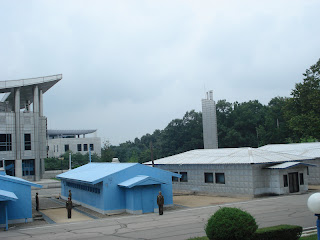 |
| A sign at the entrance to a DMZ checkpoint. It reads 'Korea is One!' |
A few words on the DMZ before we get back to pictures. 4km wide, 250km long and cutting the Korean peninsula in half along 38th parallel (the east end is slightly to the north and west end slightly to the south), the Demilitarized Zone is the most heavily militarized border in the world - so much so that it is not possible to cross the border and visitors wishing to enter the other country must take a detour to a third nation (usually China or Russia) first. The DMZ was established in a bid to bring an end to the Korean War with the signing of the Armistice Agreement by the North Korean forces and United Nations Command on July 27th 1953. It is important to note that South Korea and North Korea are still technically at war. The Armistice Agreement represents a stale-mate and an agreement not to bring forces withing 2km of the border on either side. As part of the agreement residents living in two villages situated within the DMZ, South Korean Daesong-dong (대성동) and North Korean Kijeong-dong (기정동), were allowed to remain under strict residency guidelines. The agreement also established the existence of the JSA (Joint Security Area) near the now defunct North Korean village of Panmunjom (판문점) where the Armistice Agreement was originally signed. The JSA is the only area where the two sides meet face to face and it is here where all agreements are negotiated and issues dealt with.
Interestingly, while tours from the South are supremely strict about dress and comportment (no flipflops or sandals, formal (or at the very least decently acceptable) clothing only, no khaki colours and nothing but your camera and passport as accessories once within the DMZ), warning you not to make sudden movements, shout or raise you hands above a certain height (many tour companies also make you sign waivers acknowledging that you could die), tours from the north are extremely lax. I went wearing shorts and sandals, definitely raised my hands above my head and spoke with the soldiers without issue. On the whole, it feels like an oddly peaceful place for all that it's a war zone.
 |
| Our wonderful army guide Second Leuitenant Kim - he was adorable and much less edgy than one would expect from a Major at the DMZ. |
 |
| Entering the DMZ. Although large tracts of the DMZ are unspoilt, the area around Panmunjom and Kaesong is used as farm land. |
 |
| The 'House of Peace' building in Panmunjom where the Armistice Agreement was deliberated. |
 |
| The 'Peace Museum' or 'House of Freedom' where it was officially signed. That's the Korean-language copy of the Armistice Agreement with a North Korean soldier in the background. |
 |
| Looking from Freedom to Peace. |
 |
| A worn-out UN flag near the English-language copy of the Agreement. |
 |
| The final signature of Kim Il-sung. |
 |
| The JSA. The blue buildings are the official meeting houses and straddle the Military Demarcation Line (aka the border). |
 |
| North Korean soldiers stand guard at the door leading to the South side. |
 |
| A lonely southern soldier |
 |
| Looking to the South Korean Freedom House Pavilion from the opposing North Korean Panmungak Pavilion. |
No comments:
Post a Comment